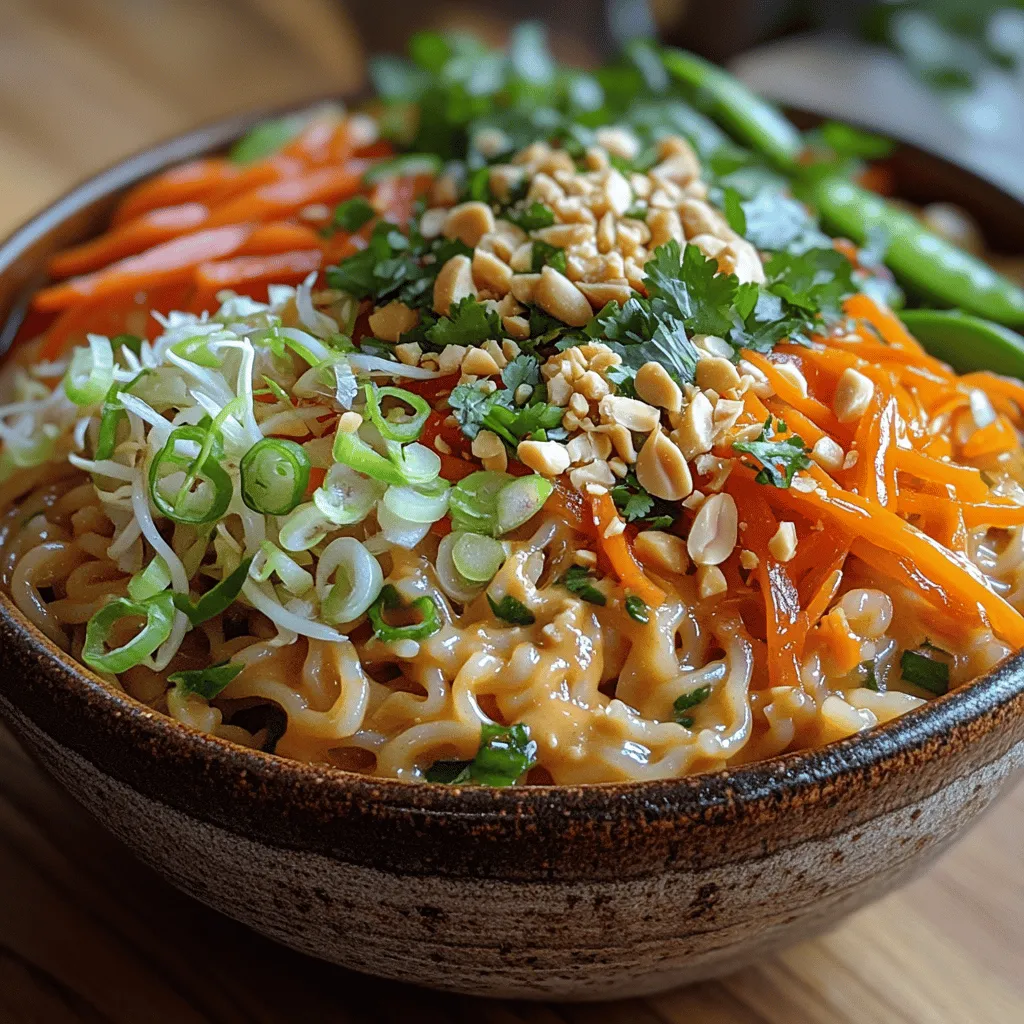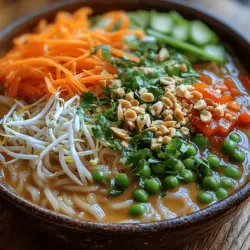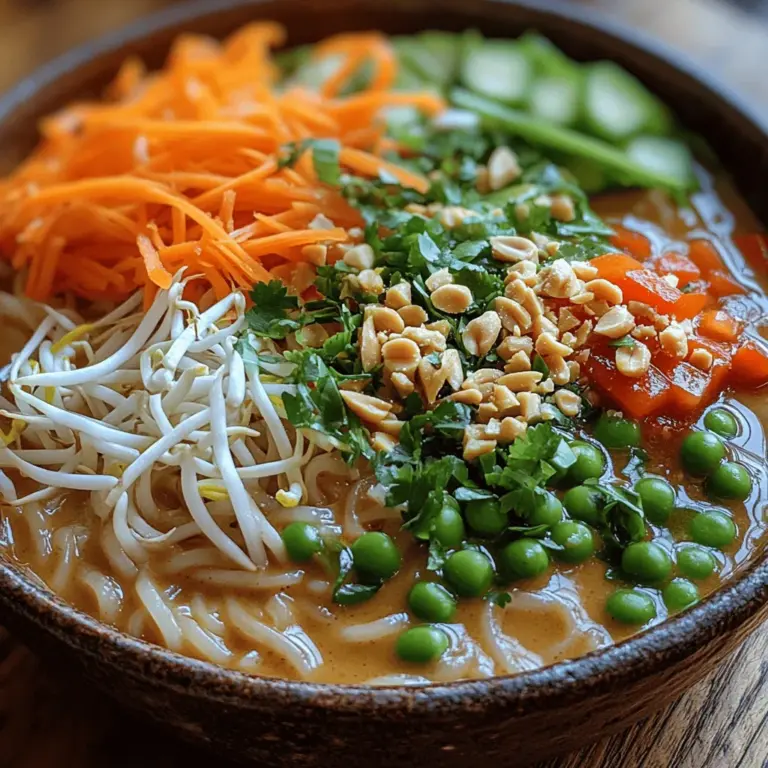Introduction
Thai cuisine has captured the hearts and palates of food lovers around the globe, celebrated for its vibrant flavors, aromatic herbs, and an exquisite balance of spicy, sweet, salty, and sour elements. Among the myriad of dishes that showcase the essence of Thai cooking, Spicy Thai Peanut Noodles stand out as a perfect representation of this culinary tradition. This dish combines the richness of creamy peanut sauce with the fresh crunch of vegetables, making it not only incredibly satisfying but also a feast for the eyes.
Spicy Thai Peanut Noodles are a fantastic choice for anyone looking to whip up a quick meal that doesn’t sacrifice flavor or nutrition. In just a matter of minutes, you can prepare a delicious and healthy dish that brings a taste of Thailand right to your kitchen. With its compelling blend of textures and tastes, this recipe is an ideal option for busy weeknights, potlucks, or a delightful lunch.
In this article, we will explore the enticing world of Spicy Thai Peanut Noodles, diving into the key ingredients that make this dish so special, followed by a detailed, step-by-step preparation guide to ensure your noodles turn out perfectly every time.
Understanding the Key Ingredients
To truly appreciate Spicy Thai Peanut Noodles, it’s essential to understand the key ingredients that come together to create this mouthwatering dish.
Rice Noodles
At the heart of this recipe are rice noodles, which are a staple in many Asian cuisines. These thin, flat noodles are made from rice flour and water, lending a unique texture that is both chewy and tender. Unlike wheat-based noodles, rice noodles are gluten-free, making them an excellent choice for those with gluten sensitivities. When cooked correctly, they can absorb flavors beautifully, allowing them to serve as the perfect canvas for the rich peanut sauce and the fresh vegetables that accompany them.
To ensure your rice noodles achieve that coveted al dente texture, it’s important to follow the cooking instructions carefully. Overcooking can lead to mushy noodles, while undercooking can leave them too firm.
Fresh Vegetables
One of the delights of Spicy Thai Peanut Noodles is the vibrant array of fresh vegetables that add color, crunch, and nutritional value. Common choices include shredded carrots, bell pepper, sugar snap peas, bean sprouts, and green onions.
– Shredded Carrots: These add a sweet and slightly earthy flavor, contributing both texture and color to the dish.
– Bell Pepper: With its crisp texture and sweetness, bell pepper enhances the overall flavor profile while providing a satisfying crunch.
– Sugar Snap Peas: These crunchy pods bring a delightful sweetness and a slight snap, making them a perfect addition.
– Bean Sprouts: Known for their fresh, crisp texture, bean sprouts provide a refreshing contrast to the other ingredients.
– Green Onions: Used both as a garnish and in the cooking process, green onions add a mild onion flavor and a pop of green.
Incorporating these vegetables not only makes the dish more visually appealing but also boosts its nutritional profile, offering a variety of vitamins and minerals essential for a balanced diet.
Peanut Sauce
The star of Spicy Thai Peanut Noodles is undoubtedly the peanut sauce, which ties all the components together with its creamy texture and complex flavor. The sauce is typically made with a combination of the following ingredients:
– Creamy Peanut Butter: This forms the base of the sauce, providing richness and a nutty flavor that is synonymous with Thai cooking.
– Soy Sauce: Adding a salty umami kick, soy sauce enhances the overall flavor while complementing the sweetness of the peanut butter.
– Rice Vinegar: This ingredient introduces a tangy element that balances the richness of the peanut sauce.
– Honey or Maple Syrup: A touch of sweetness from honey or maple syrup helps to round out the flavors, making the sauce irresistible.
– Chili Garlic Sauce: For those who enjoy a bit of heat, chili garlic sauce adds a spicy kick that elevates the dish.
– Sesame Oil: A drizzle of sesame oil brings a deep, nutty aroma that ties the flavors together.
– Lime Juice: Fresh lime juice adds brightness and acidity, cutting through the richness of the sauce and enhancing its flavor.
Together, these ingredients create a peanut sauce that is both creamy and zesty, with layers of flavor that can be adjusted to your personal preference. Whether you prefer a milder sauce or one with a more pronounced kick, the beauty of this recipe lies in its adaptability.
Step-by-Step Preparation
Now that we have a solid understanding of the key ingredients in Spicy Thai Peanut Noodles, let’s dive into the step-by-step preparation process. This section will guide you through cooking the rice noodles, making the peanut sauce, and sautéing the vegetables to perfection.
Cooking the Rice Noodles
1. Boil Water: Start by bringing a large pot of water to a rolling boil. It’s essential to use enough water to allow the noodles to move freely while cooking.
2. Add the Noodles: Once the water is boiling, add the rice noodles to the pot. Stir gently to prevent them from sticking together.
3. Cook Until Al Dente: Follow the package instructions for cooking time, which is typically around 5-7 minutes. To achieve the perfect al dente texture, taste the noodles a minute or two before they are supposed to be done. They should be tender but still firm to the bite.
4. Drain and Rinse: Once cooked, drain the noodles in a colander and immediately rinse them under cold water to stop the cooking process. This step also helps to prevent the noodles from becoming gummy.
5. Toss with Oil: To keep the noodles from sticking, toss them with a small amount of sesame oil or vegetable oil. Set them aside while you prepare the other components.
Making the Peanut Sauce
1. Combine Ingredients: In a medium mixing bowl, add 1/2 cup of creamy peanut butter, 1/4 cup of soy sauce, 2 tablespoons of rice vinegar, 2 tablespoons of honey (or maple syrup), 1 tablespoon of chili garlic sauce, and 1 teaspoon of sesame oil.
2. Mix Thoroughly: Whisk the ingredients together until smooth. If the sauce appears too thick, you can gradually add a tablespoon of warm water to achieve your desired consistency.
3. Adjust Flavor: Taste the sauce and adjust the flavors as needed. For more heat, add extra chili garlic sauce; for more sweetness, add a bit more honey or maple syrup; and for tanginess, a squeeze of lime juice can work wonders.
Sautéing the Vegetables
1. Prepare the Vegetables: While the rice noodles are cooking, wash and chop the fresh vegetables. Aim for uniform sizes to ensure even cooking.
2. Heat the Pan: In a large skillet or wok, heat 1 tablespoon of vegetable oil over medium-high heat.
3. Add the Vegetables: Once the oil is hot, add the shredded carrots, bell pepper, and sugar snap peas. Stir-fry for about 2-3 minutes until the vegetables begin to soften but still retain their crunch.
4. Add Bean Sprouts and Green Onions: Next, add the bean sprouts and a handful of chopped green onions. Stir-fry for another minute, allowing the vegetables to cook through while keeping their vibrant colors.
5. Develop the Flavor: As you sauté the vegetables, you will notice the delightful aroma filling your kitchen, a blend of fresh produce and the sizzling oil creating a savory base for your noodles.
As you finish sautéing the vegetables, you can prepare to combine all the components for a delicious and satisfying meal that truly embodies the spirit of Thai cuisine. Stay tuned for the next section of this recipe, where we will bring everything together for a delicious finish.


